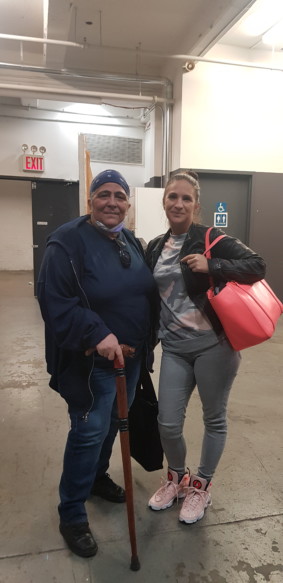In December 1971 Cornell Benjamin, a member of the Ghetto Brothers, was on his way to negotiate peace between two street gangs in the South Bronx. Before Benjamin could fulfill his quest, a pipe hit him in the skull; he was murdered.
Back then, Benjamin’s death only heightened the tension between the gangs, but his mother was clear: her son died for peace. And as a result, the Hoe Avenue Peace Meeting, attended by dozens of gangs, sealed a truce.
Benjamin, who was known as “Black Benjie” in the 70s, was nearly forgotten. His name rarely appears in print. Even people who have lived in the South Bronx their entire lives have never heard of him.
But Wednesday night, nearly 51 years after Benjamin’s death, members of the Bronx Community Board 2 unanimously agreed to sign a letter of support to co-name East 165th Street and Rogers Place, the street on which Benjamin died, Cornell “Black Benjie” Benjamin.
The effort to co-name the street was led by social worker Bonnie Massey. She is one of the long-time Bronxites who until five years ago, didn’t know who Benjamin was. After seeing the documentary Rubble Kings by Shan Nicholson, Massey became inspired to put Benjamin’s name on the map.
“Everybody talks about the Bronx was burning, blah, blah, blah, right. People don’t talk about when everybody ignored the young people that were here, Black and Latino that were here, they weren’t just gang members. They were the people that made peace,” Massey said.
And so, in 2018 the “Black Benjie Vive” campaign was born. In order to solidify his name in history and give Benjamin permanent recognition, Massey began the process of co-naming the street on which he died.
Massey is a social worker at the Bronx Community Charter School and got her students involved in her effort. Through the school, Massey met Lorine Padilla, a former gang member, retired social worker, and community activist. Padilla had met Benjamin many years ago. She said he was quiet and intelligent. Now, she describes him as a hero.
“He represents the Black and brown. He represents your community. He represents conflict resolution. He represents peace,” Padilla said.
Padilla and Massey emphasized the importance of “community heroes” in the Bronx, an area that is, according to them, still plagued by gang violence. They stress the importance of conflict resolution, schools not becoming prison pipelines, and learning about the past.
“I just think it’s the most powerful…important message for young people, particularly young people who are street-involved… The idea that people are going to have to go past that street and wonder who is Black Benjie, who is Cornell Benjamin,” Massey said.
The street is surrounded by schools and the impact on children is important to Padilla and Massey. Not only does it function as a tool for former gang members to talk to their children about the “perils of being in a gang,” but it also teaches that peace is possible, according to Padilla.
“To teach kids, you know, conflict resolution and let them know that peace can come about. If we did it, you know, they can probably do it too,” she said.
After Benjamin’s death, the truce also led to something else: hip-hop. In his book Can’t Stop Won’t Stop, historian Jeff Chang, described how the gangs shifted their energy into music.
“The peace treaty had been momentous. Change was sweeping through the Bronx. Youthful energies turned from nihilistic implosion to creative explosion,” Chang wrote.
Padilla remembered how hip hop opened up the Bronx – people could move into other gangs ‘territories’ without fear.
“Kool Herc and the guys in the corner could play their music and we could all be there,” Padilla said.
The effort to name the street after Benjamin started five years ago. Massey, Padilla, and a group of middle schoolers presented their case at a community board meeting. They were met with resistance, according to Massey and Padilla.
To change a street name there are numerous guidelines. Community Board 2 follows the city’s guidelines, according to district manager Ralph Avacedo, which include support from local communities. Additionally, they asked Massey and Padilla to find a family member to support the name change.
Angelique Benjamin Lenox became interested in Benjamin a decade earlier than Massey. However, she knew him as “Uncle Cornell.” She stumbled upon Massey’s petition to change the street name and signed it. And eventually, she got into contact with Massey in 2020, a decade after her search started.
For Lenox, changing the street name is about giving pride to children in the Bronx and recognizing Black Benjie’s significance in history.
“There was a lot of sadness that my uncle was killed, him and my dad were very close… This is just a love letter to my father,” Lenox said.
The name change passed its first hurdle at the community board economic development/municipality committee meeting earlier this month. It was Padilla’s second attempt in front of that committee and she cried as members unanimously agreed to move the name change forward.
“I know what his death did to me… To finally hear them say yes, it was like they were saying, we finally see you as you,” she said.
Now that the initiative has received a letter of support from the community board, it will move to the NYC city council, which will decide on the name. The council’s decision will most likely happen the week before Christmas, according to the City Council District 17 office. If approved, the co-naming will take place at the earliest in February 2023.

